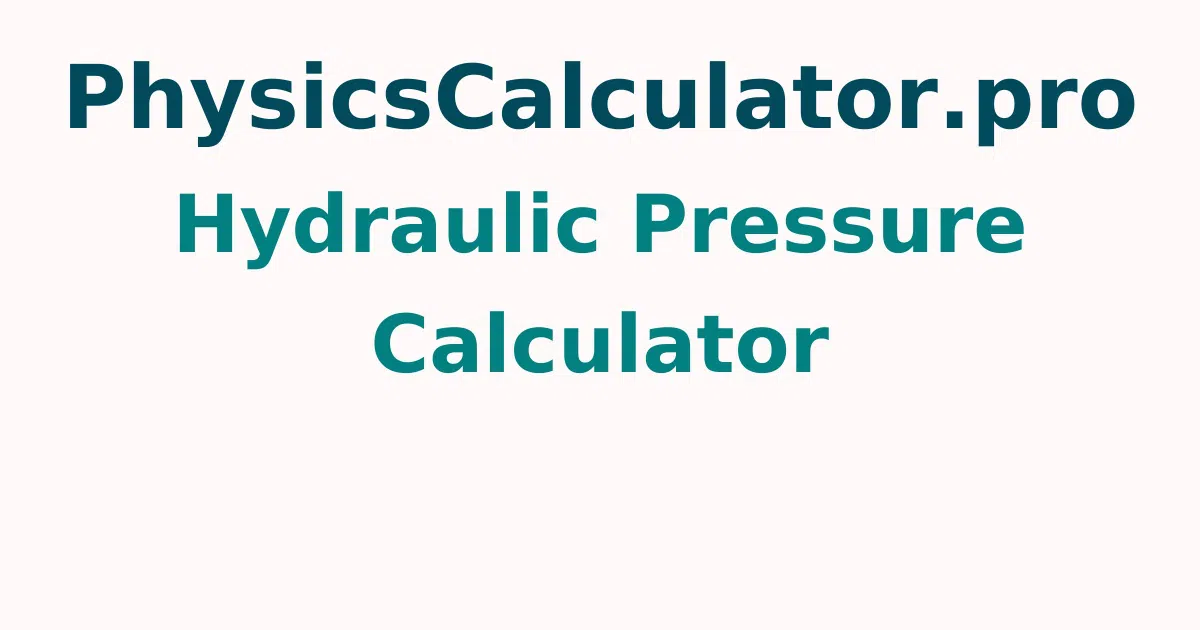Hydraulic Pressure Calculator
By entering the relevant input parameters into the Hydraulic Pressure Calculator, you can quickly determine the hydraulic pressure of a device. To acquire the liquid pressure and force of the second piston, enter the area, force of the first piston, and area of the second piston of the hydraulic system and press the calculate button.
Step-by-Step Procedure to Evaluating Acceleration
Pascal's law is used to calculate the hydraulic pressure operating on a system. In the sections below, learn how to determine the liquid pressure and force acting on a single pistol using easy procedures.
- Step 1: Get the first piston's area and force, as well as the second piston's area.
- Step 2: Subtract the force of the first piston from the area of the first piston.
- Step 3: To calculate the force exerted on the second piston, multiply the result by the area of the second piston.
- Step 4: The liquid pressure is the outcome of step 2.
What is the Principle of Pascal?
If you apply external pressure to a liquid or gas in an enclosed container, Pascal's law states that the pressure will be transmitted throughout the fluid, causing the identical shift to occur everywhere. This law was named after Blaise Pascal, who performed Pascal's barrel experiment in 1646.
He slid a long vertical tube into a water-filled barrel. Then he poured the water into the tube, causing the hydrostatic pressure to rise. The pressure inside the barrel became too great at one point, and the barrel exploded.
Pascal's concept is employed in a variety of hydraulic systems, including the hydraulic press depicted in the diagram below. Two pistols, one with a smaller surface area and the other with a larger surface area, are connected by hydraulic fluid. The pressure exerted by the smaller piston on the liquid will be exactly equal to the pressure exerted by the liquid on the larger cylinder. It is critical to emphasise that the pressures, not the forces, are equal.
Pascal's Law Formula
The formula for Pascal's law is F1/A1 = F2/A2
- Where, F₁ = force applied to the first piston
- A₁ = area of the first piston
- F₂ = force applied on the second piston
- A₂ = area of the second piston
The hydraulic press's liquid pressure can be determined in two simple ways p = F₁/A₁ and p = F₂/A₂
Another easy formula is as follows d₁ = F₂/F₁ * d₂, d₁ = A₂/A₁ * d₂
The work done by the piston is W = F₁ * d₁ = F₂ * d₂
- Where, d₁ = distance at which the first piston has moved
- d₂ = distance at which the second piston has moved
- W = total work done by the piston
For more concepts check out physicscalculatorpro.com to get quick answers by using this free tool.
Hydraulic Pressure Examples
Question 1: A hydraulic lift has two pistons with diameters of 80 cm and 7 cm. When 65 N is applied to the smaller piston, what is the force exerted by the larger piston?
Solution:
Given:
The radius of piston r = D/2
The diameter of smaller piston d₁ = 7 cm
The diameter of the larger piston d₂ = 80 cm
Area of smaller piston A₁ = π(7/2)²
= 12.25π
Area of larger piston A₂ = π(80/2)²
= 1600π
Force of the larger piston F₂ = (A₂/A₁)xF₁
= (1600π)/(12.25π) x 65
= 8489.79 N
The force of the larger piston is 8489.79 N.
FAQs on Hydraulic Pressure Calculator
1. How can you find out how much hydraulic pressure there is?
F (Force) = P (Pressure) x A(Surface Area) is the basic equation to employ. You can use P = F/A to solve for pressure by rearranging the equation.
2. What is the ideal pressure for a hydraulic press?
The maximum pressure on most presses will be no more than 200 bar or (3,000 psi).
3. In a hydraulic system, what determines the pressure?
The piston's surface area and the force pressing on it are the two components that influence hydraulic pressure.
4. What are some of Pascal's law's applications?
Pascal's law is used in hydraulic lift, where pressure applied to piston A is communicated equally to piston B without reducing the consumption of the non-compressible fluid.
